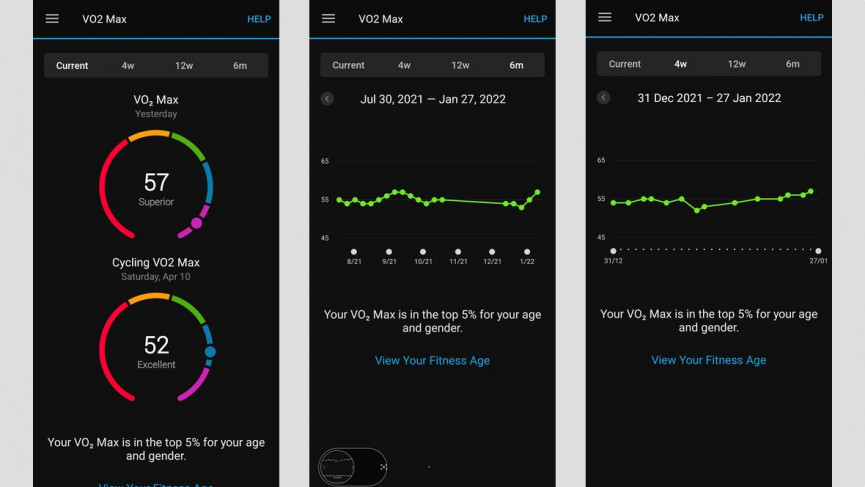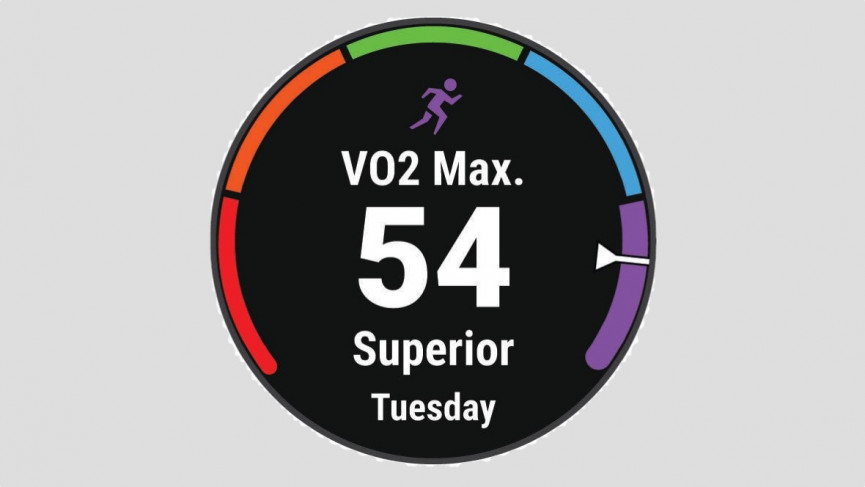
It's safe to say VO2 Max has become part of the wearable tech furniture. Particularly if it's a smartwatch or a fitness tracker that wants to help you keep a close eye on your fitness.
Fitbit has made it the basis for its "Cardio Fitness" score, which is available on the likes of the Fitbit Charge 5 and the Fitbit Versa 3.
The Apple Watch now generates its own Cardio Fitness data through VO2 Max too, and pretty much most Garmin watches offer VO2 Max estimates.
Essential reading: Heart rate variability - get to know what it brings to the fitness party
What was once not long ago a metric for elite athletes, has become a piece of fitness data that recreational runners and gym lovers can start to obsess over and pay attention to.
But what exactly is VO2 Max? How useful is it as a measure of overall fitness and, most importantly, can you trust a fitness tracker or smartwatch to give you an accurate reading?
We delve into the murky world of VO2 Max to help answer all those questions and more.
What is VO2 Max?

VO2 Max is an abbreviation for the maximum volume of O2 (oxygen), which is transferred to the blood.
It's measured in millilitres of oxygen processed per kilogram of body weight every minute.
The amount of oxygen you transfer to your blood changes and increases as you start exercising, VO2 Max is the level at which the amount of oxygen being processed maxes out and plateaus.
As you train, your body learns to pass more oxygen – which improves your aerobic fitness and performance.
So VO2 Max is the best measure of your fitness, and a great way to track your improving performance.
Why is VO2 Max such a good metric?
We've written thousands of words here at Wareable about heart rate, and how it's a constant figure that can provide a baseline for your training.
While that's true, it's only a constant measure of effort e.g. how hard you're working. In reality, it can be hugely affected by heat, terrain, fatigue to name but a few outside factors.
VO2 Max isn't affected by outside factors – and is a measure of your potential. While it does a different job to training by heart rate, it's an unbeatable tool for gauging your fitness.
Which devices track VO2 Max?

There are plenty of wearables to choose from if you're looking to get up close and personal with your VO2 Max.
Apple, Fitbit, Garmin, Polar, Samsung and Huawei among others, all offer the ability to view to track and view VO2 Max estimates. Here's just a small selection of the devices that offer it right now:
- Apple Watch Series 7, Apple Watch SE and Apple Watch Series 3
- Garmin Fenix 7, Garmin Forerunner 245, Garmin Venu 2
- Fitbit Charge 5, Fitbit Versa 3
- Samsung Galaxy Watch 4
- Huawei Watch GT3, Huwaei Watch GT Runner
- Polar Vantage V2, Polar Grit X Pro
Why is tracking VO2 Max essential for fitness fans?

So what are the benefits of knowing your VO2 Max? Garmin offers a good explanation of that in its own breakdown of the VO2 Max Estimates that Garmin compatible watches can deliver.
VO2 Max offers a better understanding your fitness level, looking at the maximum rate that you can bring oxygen into the body, then transport it to muscles to fuel your aerobic energy production.
A low VO2 max score can indicate a sign of poor fitness levels, while a higher score can suggest you have a greater capacity to perform during exercise.
Your VO2 max will adjust depending on your lifestyle and training habits. So you can track your improvement over time, and understand your potential if you're getting back into shape.
Garmin has sought to make it more insightful for those who spend their training time off-road. The new trail run VO2 max rolled out on the likes of the Garmin Enduro and Fenix 7 watches are an example of that.
You can compare VO2 Max figures to others to see how it stacks up. It can help you better understand the level of fitness you need to reach in order to be competitive for a competition or to keep in check with other fitness-loving friends.
How is VO2 Max calculated on wearables?

A proper VO2 Max test done in a lab requires you to wear a mask, while completing an increasingly strenuous treadmill run. The volume of oxygen entering and leaving your lungs is measured, and blood oxygen tested using blood samples taken from the finger. Sound fun? We've done it and it's absolutely not, which is where wearables come in.
Clearly, that's not within the capability of a wristband or watch, so measurements are always going to be an estimate.
The likes of Fitbit and Apple take care of VO2 Max calculations for their devices while Garmin relies on Firstbeat Analytics, a company it acquired in 2020, for its physiological data. The company's algorithms were prevalent on a host of wearable devices prior to that acquisition including heart rate monitoring headphones built by Jabra.
The key is getting your age, sex and weight inputted into the device correctly, as this data underpins many of the assumptions your device will make about you. But the next crucial elements are heart rate and your pace/speed, which can both be accurately measured from wearable devices. We're going to ignore the issue of optical heart rate accuracy here, but clearly, bad data is going to cause anomalous VO2 Max scores.
1) The personal background info (at least age) is logged.
2) The person starts to exercise with a device that measures heart rate and speed.
3) The collected data is segmented to different heart rate ranges and the reliability of different data segments is calculated.
4) The most reliable data segments are used for estimating the person's aerobic fitness level (VO2max) by utilising either linear or nonlinear dependency between the person's heart rate and speed data.
How to change your VO2 Max score

Working on your aerobic activity is still the best way to affect your VO2 Max score, and Firstbeat says that you should be able to see a physiological change in 4-12 weeks.
"A beginner may increase his/her fitness level during 4-10 weeks of successive training by up to 10-20%," its white paper says.
But it's also key to make sure that your exercise intensity matches your VO2 Max. If you're not training hard enough you could see levels decreasing.
How accurate are VO2 Max estimates?
Wearable tech is based on a lot of estimations, and we often compromise on accuracy for convenience. That's certainly the case here, where a proper VO2 Max test is expensive, gruelling and uncomfortable.
There isn't data for all VO2 Max devices, but in its white paper, Firstbeat claimed a 95% accuracy, based on 2,690 runs from 79 individuals. We'd judge that to be a pretty decent compromise, given the simplicity of getting the data.
"In a vast majority of the measurements, the error was below 3.5 ml/kg/min and the error was evenly distributed around the mean value. For perspective, the error in a typical indirect sub-maximal test is 10-15% and in a direct laboratory test about 5%," the report said.
With the rise of optical (light-based) heart rate monitors that offer VO2 Max testing, there is a big question mark over accuracy. Using chest straps to generate those VO2 Max assessments is a method companies still adopt as it remains the gold standard. Ultimately, if you're not generating a high precision of accuracy, it will be hard to truly benefit from it.
Things are clearly getting better on the optical heart rate monitoring front, but there's a reason why many companies that offer VO2 scores still recommending using a chest strap for getting accurate training and fitness insights.
Can your VO2 Max score be wrong?
You do have to be careful about VO2 Max. When running uphill, your heart rate is typically higher and your speed is slower, which could be evaluated as a lower fitness level. The opposite can be true for downhill runs. But as long as your runs and training schedule has a good mix of routes, all should be OK.
Those who exclusively run trails can find VO2 Max estimates to be too low, thanks to the inherently slower nature of running away from the asphalt. That's why Garmin introduced a trail VO2 Max score on its outdoor watches.
Ultimately, make sure you get out plenty of times and track sessions and workouts before you start obsessing over your scores.
How we test
